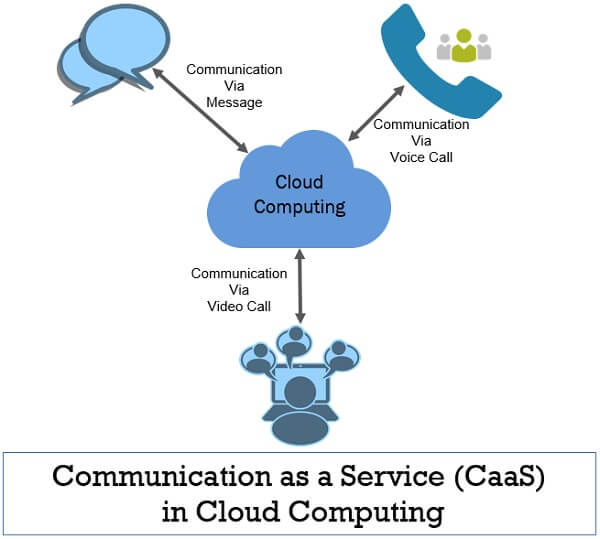Communication as a Service (CaaS) is a trending service provided to the customers by CaaS vendors that is implemented over cloud computing technology. Nowadays communication has become the most crucial aspect of businesses. A complete communication solution can help the business grow fast. In this content, we will discuss CaaS, its features, how does it work, the risk involved and it’s advantages.
What is Communication as a Service (CaaS)?
Communication as a service (CaaS) is a cloud-based solution provided by cloud vendors. CaaS is a specialized variation of Software as a Service (SaaS) which is among three basic services delivered by the cloud computing technology. When we talk about communication, recall, in how many ways we can communicate with others. Well, we can communicate via text message, voice call and video call.

CaaS providers manage the hardware and software that are important for delivering Voice over IP (VoIP) for voice communication service, and other services like Instant Messaging (IM) to provide text communication service and video conferencing to provide video communication service.
CaaS model provides economical services as the service users do not have to bear the expenditure of buying and managing the communication equipment. CaaS is favourable for small IT companies that on the verge of expansion. Let us discuss the features of CaaS.
Features of CaaS
1. Integrated and Unified Communication
The advanced unified communication features include Chat, Multimedia conferencing, Microsoft Outlook integration, Real-time presence, “Soft” phones (software-based telephones), Video calls, Unified messaging and mobility.
Nowadays, CaaS vendor introduces new features to their CaaS services much faster than ever before. It has become economical for providers to introduce a new feature to their CaaS application faster because the end-users are benefitting from the provider’s scalable platform infrastructure and ultimately the many end-users using the provider’s service shares this cost of enhancement.
2. No Investment Required
As we have learnt above it is the sole responsibility of CaaS vendor to manage hardware and software deployed to provide the communication service to their customers. The customer only has to pay for the service he is getting from the CaaS vendor, not for communication features deployed to provide communication services.
3. Flexibility & Scalability
The customer can outsource the communication services form CaaS vendors. The customers pay for what they have demanded. The customer can extend their service requirement according to their need. This brings flexibility and scalability in communication services and even make the service economical.
4. No Risk of Obsolescence
The CaaS vendors keep on updating their hardware and software that provide communication services to meet the changing demands of the market. So the customer using the services does not have to be worried about the service obsolescence.
5. No Maintenance Cost Incurred
The customer outsourcing the CaaS service does not have to bear the cost of maintaining the equipment deployed for providing communication services.
6. Ensure Business Continuity
If due to any calamity your business’s geographical region is affected then how long can you continue your business? That’s why nowadays companies distribute their data to the geographically dispersed data centre which maintain the redundancy & help them in recovering soon after any catastrophic event.
The same feature is adopted and implemented by the CaaS providers in order to provide voice continuity or communication continuity even if any catastrophic event strikes.
How Communication as a Service (CaaS) Works?
Business users opting for CaaS can selectively deploy communication features (hardware and software) throughout there office on a pay-as-you-go basis. CaaS vendor designs comprehensive, flexible and easy to understand service plans for their users.
The quality of communication service is assured by the CaaS vendors under the service level agreement. CaaS is a fully hosted solutions that are practised on the cloud-based technology which can be implemented over multiple types of operating system such as windows, Linus, Android & iOS. Because of this, the CaaS can be accessed through multiple types of connected devices such as mobiles, handsets, tablets, TV sets, laptop, PC etc.
CaaS has brought the revolutionary change in method of communication from person to person, person to machine and machine to machine.
CaaS abstracts the networks capability to handle peak load for their customer which make it flexible. The network capabilities can be extended to raise the network capacity, devices and area coverage based on the demands of the CaaS customers. However, the network capabilities can be extended dynamically according to customers demand so that the resources are not wasted.
Risk Involved in CaaS?
As we have mentioned earlier that the CaaS vendors are solely responsible for the quality of the service they provide. So from the customer’s perspective, there is no risk involved in taking the services from the CaaS vendor.
The customers need not worry about the service being getting obsolete as the CaaS providers perform periodic updates and they also manage the replacement of hardware and software involved to keep the platform technically up to date.
Advantages of Communication as a Service (CaaS)
- CaaS provides an economical way to deliver communication service to its customer by preventing them from investing in hardware and software required for delivering communication services.
- CaaS vendor provides 24/7 service to its customers.
- Customer receiving services from CaaS vendor do not have to indulge and invest in managing the components of CaaS.
- CaaS vendor offers flexible service as they charge according to pay as you go basis.
- CaaS provide scalable services as they provide service based on customers demand.
- CaaS provides the hosted and managed solution which offers complete communication solutions managed by a single vendor only.
- From the customers perspective, there is no risk of service becoming obsolete as the vendors are responsible for upgrading the carrier platform.
CaaS is all about recognizing the use cases where this technology can be implemented to utilize the full value potential of telecommunication.

Leave a Reply